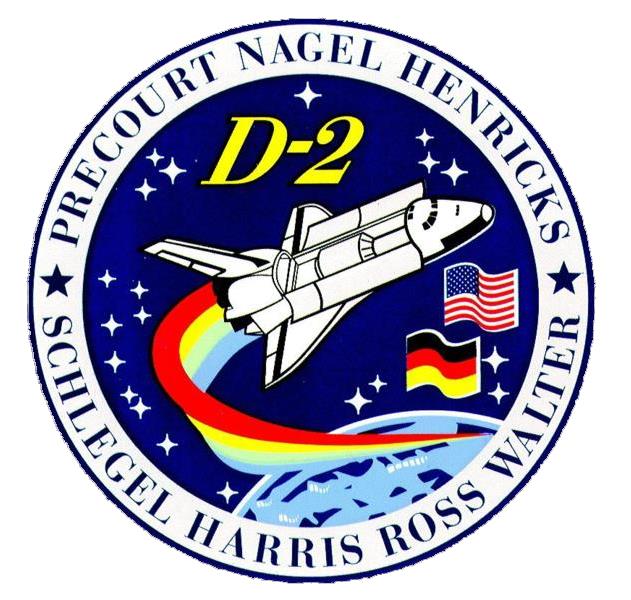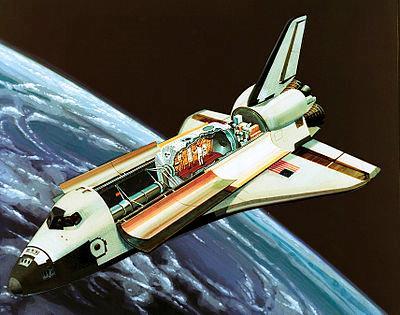Charles J. Prescourt
Spacelab Space Missions
Spacelab 016 - STS-55
Mission Name: Spacelab D2
Astronauts:
Command Pilot:
Steven R. Nagel
(Fourth Space Flight)
Pilot:
Terence T. Hendricks
(Second Space Flight) Mission Specialist 1:
Jerry L. Ross
(Fourth Space Flight) Mission Specialist 2:
(First Space Flight)
Mission Specialist 3:
Bernard A. Harris
(First Space Flight) Payload Specialist 1:
Ulrich Walter
DFVLR
(First Space Flight) Payload Specialist 2:
Hans Schlegal
DFVLR
(First Space Flight)
Spacelab was a reusable laboratory used on certain spaceflights flown by the Space Shuttle. The laboratory comprised multiple components, including a pressurized module, an unpressurized carrier and other related hardware housed in the Shuttle's cargo bay. The components were arranged in various configurations to meet the needs of each spaceflight.
Spacelab components flew on 22 Shuttle missions between November 1983 and April 1998. Spacelab allowed scientists to perform experiments in microgravity in Earth orbit.
D-2 became the second Spacelab flight under German mission management; around-the-clock operations performed by crew, divided into two teams. Some 88 experiments were conducted, covering materials and life sciences, technology applications, Earth observations, astronomy and atmospheric physics. Material science investigations were: Material Science Experiment Double Rack for Experiment Modules and Apparatus (MEDEA); Werkstofflabor (WL); Holographic Optics Laboratory (HOLOP); and on Unique Support Structure (USS) located aft of D-2 in cargo bay, Material Science Autonomous Payload (MAUS), and Atomic Oxygen Exposure Tray (AOET). Also located on USS, Radiation Detectors (RD) experiments. One crystal growth experiment yielded 0.78-inch (20-mm) crystal of gallium arsenide, largest produced in space to date.
Life science research performed with Anthrorack (AR); Biolabor (BB); and Baroreflex (BA). Anthrorack, advanced mini-diagnostic laboratory, allowed most comprehensive medical screening to date of human adaptation to weightlessness. Harris, a medical doctor, set up first I.V. (intravenous) line in space, injecting Schlegel with saline as part of study to replace body fluids lost during adaptation to weightlessness. Other payload crew members also participated.
Tests with Robotics Experiment (ROTEX), an advanced robotic assembly provided by Germany, were highly successful. ROTEX robotic arm performed first by capturing free-floating object in space via remote control from Earth. Crew achieved two-way communications with Crew Telesupport Experiment, which featured onboard Macintosh computer to establish data link with ground control. Five crew members communicated with school children worldwide through Shuttle Amateur Radio Experiment (SAREX); Nagel also made contact with Russian cosmonauts aboard the Mir space station.
Problems encountered were an overheating orbiter refrigerator/freezer unit in middeck which forced reliance on backup to store experiment samples, and a leaking nitrogen line in wastewater tank which required an on-orbit fix. Communications with Columbia was lost for about an hour and a half on May 4 due to errant command from Mission Control in Houston. On May 2, mission managers determined enough electrical power remained to extend the flight by one day.






![]()
![]()
![]()
Study Research
Space Cosmology
Science Research
*
About
Science Research
Science Theories
Site Map
BookShelf
Desk
Copyright © by Nigel G Wilcox · All Rights reserved · E-Mail: ngwilcox100@gmail.com
Designed by Nigel G Wilcox
Powered By AM3L1A
Pages within this section: Spacelab 01-32
Spacelab B11-20
Sub-Menu
11
M
menu
12
13
14
15
16
17
8
19
20
18
>>>
C
SM









